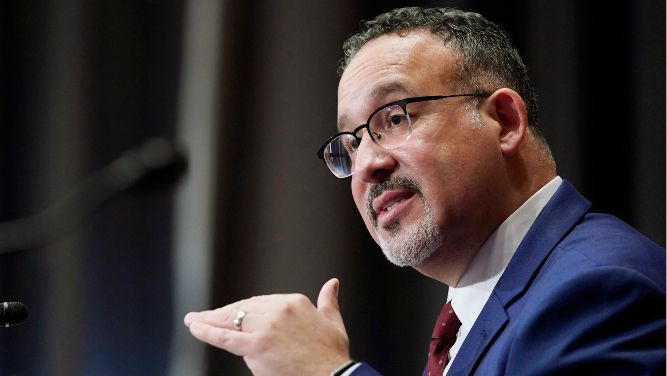The United States Education Department announced Thursday that it is eliminating more than $5.8 billion in student debt for more than 323,000 borrowers with severe disabilities.
"Today's action removes a major barrier that prevented far too many borrowers with disabilities from receiving the total and permanent disability discharges they are entitled to under the law," Education Secretary Miguel Cardona said in a statement Thursday.
"We've heard loud and clear from borrowers with disabilities and advocates about the need for this change and we are excited to follow through on it," he added. "This change reduces red tape with the aim of making processes as simple as possible for borrowers who need support."
The federal government offers student debt relief for people who are “totally and permanently disabled” and have limited incomes, but the current rules require them to submit documentation of their disability and undergo a three-year monitoring period to prove they’re earning little pay. The move marks the start of a broader overhaul of a program that has been criticized for having overly burdensome rules.
“This is going to be a smooth process for our borrowers,” Secretary Cardona told reporters on a call. “They’re not going to have to be applying for it or getting bogged down by paperwork.”
Tens of thousands of people have been dropped from the program and had their loans reinstated simply because they failed to submit proof of their earnings, however, and critics say the complex rules deter some from applying.
Advocates have pressed the Education Department to eliminate the monitoring period entirely and to provide automatic debt relief to people who the Social Security Administration already identifies as permanently disabled.
Under the new action, both demands will be met. Starting in September, the Education Department will start erasing student debt for 323,000 Americans identified in Social Security records as being permanently disabled.
Borrowers will be notified once they have been approved for relief. All of the loans are expected to be discharged by the end of the year.
The department also plans to eliminate the program’s three-year monitoring period, which was previously suspended during the pandemic. That change is expected to be cemented during a federal rulemaking process set to start in October, the agency said.
Secretary Cardona announced the change as the Biden administration faces mounting pressure to pursue wider debt forgiveness.
Currently, student loan payments are on pause through January due to the ongoing COVID-19 pandemic, thanks to an extension enacted by the Biden administration last month.
“The payment pause has been a lifeline that allowed millions of Americans to focus on their families, health, and finances instead of student loans during the national emergency,” said U.S. Secretary of Education Miguel Cardona in a statement at the time
But pressure is mounting on the White House and Congressional Democrats to take action.
Democrats including Senate Majority Leader Chuck Schumer, N.Y., and Sen. Elizabeth Warren, Mass., have called on Biden to erase $50,000 in student debt for all borrowers as a way to jumpstart the economy.
Advocates, like New York Rep. Mondaire Jones, who spoke to Spectrum News about the issue earlier this summer, said canceling debt would boost the economy and aid low-income borrowers. Critics of loan cancellation argue it would hurt the federal budget and put taxpayers on the hook for others' loans.
When the student loan moratorium was still set to end on September 30, polls showed a majority of borrowers were not ready to start payments again. A Pew Trusts survey of about 1,500 borrowers found that two-thirds said it would be difficult to resume paying their loans. And another from the advocacy organization Student Debt Crisis found 86% of borrowers surveyed said the pandemic freeze on payments made them more likely to support permanent cancellation.
Biden has asked the Education and Justice departments to assess the legality of mass debt cancellation. Secretary Cardona said Thursday that those conversations are “still underway.” A spokesperson for the Education Department told Spectrum News in July that the review “remains ongoing.”
Meanwhile, Secretary Cardona said his agency is working to improve other debt forgiveness programs that target specific groups of borrowers: “It’s an effort to show that we are working to improve targeted loan relief and help our borrowers."
Spectrum News' Austin Landis and The Associated Press contributed to this report.



